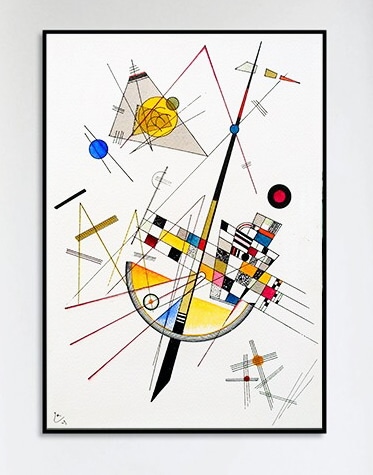Wassily (Vasily) Kandinsky (1866 – 1944) is known as one of the pioneers of abstract modern art. He was born in in Moscow to upper-class parents of mixed ethnic origins. At an early age, Kandinsky showed a rare sensitivity towards music and the arts, which his father strongly supported. Kandinsky decided to study law, ethnography, and economics, and started successfully lecturing at the university. Despite his success as an educator, he fully focused on the arts and attended art school in Munich at the age of 30. There he studied under Franz von Stuck at the Academy of Fine Arts. Introduced to the artistic avant-garde, he later co-founded the artist’s association and school “Phalanx“, opposing conservative views of the traditional art institutions. Kandinsky familiarized himself with the growing movement of ExpressionismExpressionism in fine arts was a modernist movement, which originated in Germany in the late 19th and early 20th century. Its roots of can be traced to Post-Impressionist artists like Edvard Munch in Norway, and Gustav Klimt of the Vienna Secession. Core attribute of Expressionism is the tendency to present the world solely from a subjective perspective, distorting objects radically More travelling through Europe and on this basis developed his own style.

Kandinsky came to the notion that only total abstraction could offer profound, transcendental expression. Contrary, copying from nature would interfere with this process. His mature pictorial language only loosely related to the outside world, and instead expressed the artist’s inner experience. The development of this concept can be seen in his three artistic phases, moving from his early, representational pictures full of symbolismSymbolism was a late 19th-century art movement of French, Belgian, and Russian origin. Poets and fine artists were seeking to represent absolute truths using metaphorical images in reaction against realism and naturalism. Content of both images and poetry were suggestive contents to express mystical ideas, emotions, and states of mind. Paul Gauguin, Nave Nave Mahana (1869) The term was coined More to operatic compositions, and finally to his late, geometric flat planes of colour.
Kandinsky’s ideas influenced European artists strongly, including his later students at the BauhausThe Bauhaus movement originated as a German school of the arts in the early 20th century. Founded by German architect Walter Gropius in 1919, the school was dedicated to uniting all branches of the arts under one roof. The Bauhaus acted as a hub for Europe's most experimental creatives, with well-known artist instructors like Wassily Kandinsky, Josef Albers, and Paul More to the Abstract Expressionists in the second half of the 20th century.
